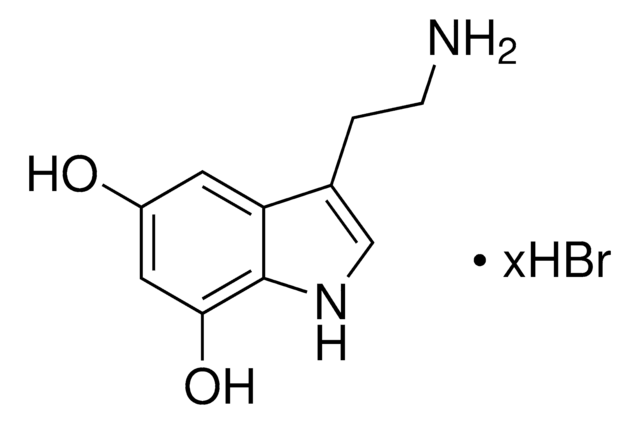H4381
6-Hydroxydopamine hydrochloride
≥97% (titration), powder, neurotoxin
Synonym(s):
2,4,5-Trihydroxyphenethylamine hydrochloride, 2,5-Dihydroxytyramine hydrochloride, 2-(2,4,5-Trihydroxyphenyl)ethylamine hydrochloride, 6-OHDA
About This Item
Recommended Products
product name
6-Hydroxydopamine hydrochloride, ≥97% (titration), powder
Assay
≥97% (titration)
form
powder
color
off-white to brown
mp
232-233 °C (dec.) (lit.)
solubility
H2O: >50 mg/mL, clear, yellow to brown
storage temp.
room temp
SMILES string
Cl.NCCc1cc(O)c(O)cc1O
InChI
1S/C8H11NO3.ClH/c9-2-1-5-3-7(11)8(12)4-6(5)10;/h3-4,10-12H,1-2,9H2;1H
InChI key
QLMRJHFAGVFUAC-UHFFFAOYSA-N
Looking for similar products? Visit Product Comparison Guide
General description
Application
- to induce Parkinson′s disease (PD) in rats
- to analyse cytotoxic effect of 6-OHDA on PC12 cell line
- to induce noradrenergic (NA) neuron deletion from the locus-coeruleus
Biochem/physiol Actions
Caution
Reconstitution
Signal Word
Warning
Hazard Statements
Precautionary Statements
Hazard Classifications
Eye Irrit. 2 - Skin Irrit. 2 - STOT SE 3
Target Organs
Respiratory system
Storage Class Code
11 - Combustible Solids
WGK
WGK 3
Personal Protective Equipment
Certificates of Analysis (COA)
Search for Certificates of Analysis (COA) by entering the products Lot/Batch Number. Lot and Batch Numbers can be found on a product’s label following the words ‘Lot’ or ‘Batch’.
Already Own This Product?
Find documentation for the products that you have recently purchased in the Document Library.
Customers Also Viewed
Our team of scientists has experience in all areas of research including Life Science, Material Science, Chemical Synthesis, Chromatography, Analytical and many others.
Contact Technical Service










